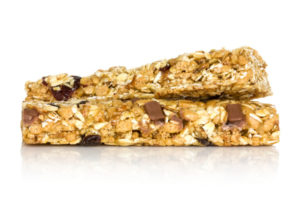 Over the years, protein bars have become popular after-workout meals for athletes and “healthy” alternatives to candy bars and other less nutritional snacks. But are they really healthy?
Over the years, protein bars have become popular after-workout meals for athletes and “healthy” alternatives to candy bars and other less nutritional snacks. But are they really healthy?
As more and more companies have entered the protein bar market, the number of product options has grown. Some products of course will be healthier than others, but what is interesting is that some touted “healthy” items are not even nutritious at all.
The average consumer doesn’t have the time to research different ingredients to learn what they do and whether they are good or bad. Companies know that most shoppers will read and trust product packaging without question.
 Consumers will not read an ingredient label – or even understand what it means anyway. Thus, lots of people are going out of their way to purchase a product that they believe will benefit them, when in actuality it is loaded with a bunch of unhealthy and sometimes detrimental ingredients.
Consumers will not read an ingredient label – or even understand what it means anyway. Thus, lots of people are going out of their way to purchase a product that they believe will benefit them, when in actuality it is loaded with a bunch of unhealthy and sometimes detrimental ingredients.
I am not your average shopper, though. I am one of those crazy “label readers”. Here is a short list of ingredients I avoid when buying protein bars (or any food for that matter).
1. Maltitol Syrup
Maltitol is a sugar alcohol used in exchange of or in addition to regular sugar in protein bars and other foods. It does provide benefits, such as fewer calories and not promoting tooth decay. However, it tends to promote gas and have a laxative effect, especially when you have more than one bar. No thank you!
Back in the day, I used to be a fan of low calorie or no calorie sweeteners. However, I think differently now. Most are processed in a way that negatively affects our bodies. Furthermore, the sweet taste (whether low calorie or not) stimulates my taste buds to want more sweet food. I don’t need help with that.
2. Trans Fats
Sure, most us have heard the bad rap about trans fats, but this is not what is listed on product labels. What a convenient labeling trick! “Hydrogenated” is the danger word in my book. If I see anything like “partially hydrogenated palm kernel oil”, or “hydrogenated coconut oil”.
3. Fractionated OIl
So what about “fractionated oil”? This is a common ingredient on protein bar labels due to the fact that it helps product icing and coatings from melting as quickly. Fractionated Oil is not as bad as hydrogenated oil, but it is still processed and therefore an ingredient to avoid.
4. Sugar and High Fructose Corn Syrup
It’s hard to avoid sugar, it seems to be in every processed product on store shelves. Sugar is an ingredient in most protein bars today. However, the problem I have is not with the sugar itself but with the fact that sugar is usually one of the main ingredients – if not the first one.
This is awful. Why not just take a bag of sugar to the gym and eat it?
Similar to trans fats, don’t just look for the word sugar. High fructose corn syrup, corn syrup act just like sugar in that they will just go right to out waistlines. Somes like a great reward for that gut-busting 60-minute workout we just did.
5. Soy
A big problem with soy in processed foods is that the majority of soybeans grown in the USA are genetically modified and has been said to interfere with our hormones. Soy in moderation, according to the Dana Farber Cancer Institute, is said to be ok, but high concentrations such as those in some protein bars should be avoided. The common ingredient you may see listed in protein bars is soy protein isolate, but I have also seen isolated soy protein or soy protein concentrate.
Soy lecithin, on the other hand, is used in protein bars as an emulsifier (to improve product consistency and shelf life) in very small amounts and therefore does impact my decision on whether or not to buy a product.
For all of you soy-lovers, know that I used to eat tofu right out of the container… with soy sauce on it no less. I am one of the few that actually likes the flavor and texture. However, I had to cut it out once I realized that soy has some significant negative side effects.
6. Coloring and Dyes
I don’t need you to color my food, thank you.
In my opinion, it is ideal to stick with whole foods. However, if you eat packaged items, look for products that list fewer ingredients – all of which you know what they are. For example, the AMRAP Bar contains just 8 ingredients.
When I see a label with hundreds of ingredients listed, I don’t even read it. I set it right back on the shelf. I’d rather go read a good book. =)

